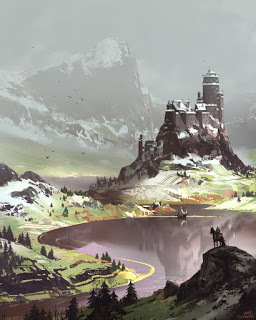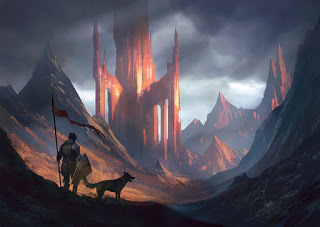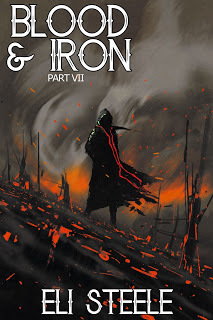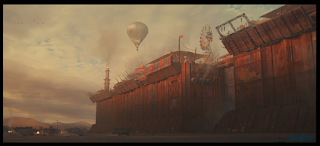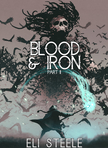Eli Steele's Blog
November 13, 2020
Beneath a Brass Sky Spotlight: Caravansaries
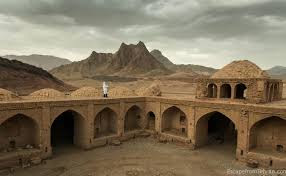
In Beneath a Brass Sky, near the eastern edge of the Brasslands, the wayfarers stay in a holdover - a caravansary. To me, reaching the caravansary is an important moment in the story, because it represents Ulfric triumphing over the harshness of the Brasslands. Up to this point, arguably, the most dangerous antagonist was the environment itself. But that's another post. Today, I want to talk about caravansaries.
A caravansary was a roadside inn where travelers (caravaners) could rest and recover from a journey. They supported the flow of both commerce and information across the trade routes the sprawled across Asia, MENA, and SE Europe - especially the Silk Road, according to Wikipedia.
In short, Caravansaries were the fortified roadside tavern of the East, though often much larger. Here's a link to some notable caravansaries.
UNESCO has this to say about their origins:
There is relatively little known about the origins of the caravanserai. Etymologically, the word is a compound of the Persian kārvān, meaning caravan or group of travelers, and sara, a palace or enclosed building, with the addition of the Turkish suffix -yi. One of the earliest examples of such a building can be found in the oasis city of Palmyra, in Syria, which developed from the 3rd century BC as a place of refuge for travelers crossing the Syrian desert. Its spectacular ruins still stand as a monument to the intersection of trade routes from Persia, India, China and Roman Empire. As trade routes developed and became more lucrative, caravanserais became more of a necessity, and their construction seems to have intensified across Central Asia from the 10th century onwards, particularly during periods of political and social stability, and continued until as late as the 19th century. This resulted in a network of caravanserais that stretched from China to the Indian subcontinent, Iran, the Caucasus, Turkey, and as far as North Africa, Russia and Eastern Europe, many of which still stand today.
 This site has a cool map of known caravansaries in Turkey.
This site has a cool map of known caravansaries in Turkey.Iranica Online talks about caravansary layout:
The normal caravansary consisted of a square or rectangular plan centered around a courtyard with only one entrance and arrangements for defense if necessary. Whether fortified or not, it at least provided security against beasts of prey and attacks by brigands. This architectural type developed in the 1st millennium b.c. in Urartian and Mesopotamian architecture (Kleiss, 1979; Frankfort, pp. 73ff.) and was further evolved in the ancient world, in the palace architecture of the ancient Greeks, for example, the palace of Demetrias called the Anaktoron, with rooms opening from a large colonnaded courtyard (Marzolff; pp. 42ff.); Greek and Roman peristyle houses; and a.d. 3rd- and 4th-century Roman castles like Burgsalach (Ulbert and Fischer, p. 87, fig. 67) and the Palast-Burg in Pfalzel, near Trier (Cüppers, pp. 163ff.). The same building type persisted in the Near East in structures like the church-house from Dura Europos (a.d. 3rd century; Klengel, p. 162). It achieved its fullest expression, however, in the work of Muslim architects: in the desert palaces of the Omayyads, hypostyle (or “Arab”) mosques, Koran schools (madrasas), and above all rebāṭs and caravansaries. It thus played an integral part in the architectural history of the Islamic lands. The Crusaders brought it to Europe, where it was combined with the cruciform aisles of Christian architecture and adopted for the castles of the Teutonic Knights (Holst), as well as for Renaissance (e.g., the castle of Aschaffenburg; Wasmuths Lexikon, p. 191) and Baroque palaces (Wasmuths Lexikon, pp. 321ff.); it survived in modern architecture in buildings for special purposes, like 19th-century museums (e.g., the Kunstgewerbemuseum in Berlin).
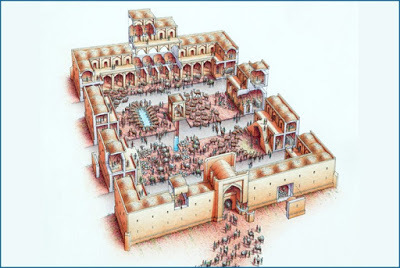
But don't take their word for it, why not stay in an ancient caravansary yourself? But if you don't have time for a holdover, perhaps you can plan a day trip to one of the oldest and largest remaining structures.
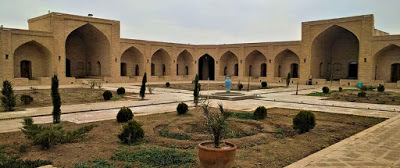
A
Check out Beneath a Brass Sky, too!
November 2, 2020
Beneath a Brass Sky, Cover Evolution - 4
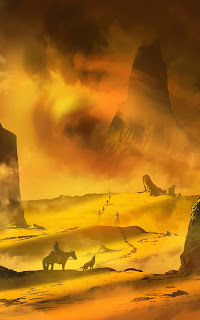
We didn't change much in this iteration of the cover for Beneath a Brass Sky. Michal (https://www.artstation.com/kvacm) really breathed life into the storm that's battering the high crag that the Wayfarers are driving towards. I like the addition of the birds, too. It's a minor detail, but vultures and other winged things have recurring roles in the story. I look into that maw in the storm - where the dust is swirling, and the wind is howling, and the waning light of a dying sun is breaking through the grit - and feel the dread that Ulfric must feel as he gazes into the unknown.
October 30, 2020
Beneath a Brass Sky, Cover Evolution - 3
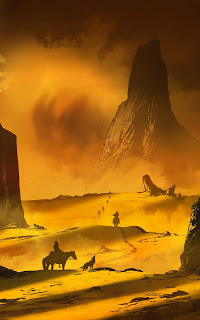
In this revision to the cover of Beneath a Brass Sky, Michal (@kvacm - twitter) began to add color and more detail. I love the dust storm (maybe the outer bands of a wilding?) swirling around the sandstone sentinel. All through the scene is a feeling of grit, and suffering, and dread. And yet, Ulfric and Spero are drawn ever east, and the remainder of the Wayfarers with them. What lies beyond that distant peak? A hollow country, no doubt. One that swallows men up.
October 28, 2020
Beneath a Brass Sky, Cover Evolution - 2
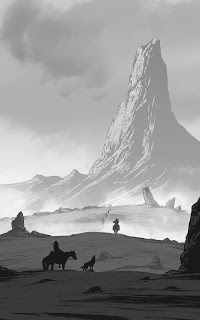
The above was the second draft for the cover for Beneath a Brass Sky. In this iteration, we narrowed up for the ebook ratio (1.6:1) and turned the Wayfarers so that they were aimed towards the horizon rather than across it (East. Always East . . .)
In the foreground is Ulfric, reined up with the brindle. In this shot, the tail of his shemagh is flapping in the wind, but it looked a bit too much like a ponytail, so we nixed that detail.
To me, this scene is so evocative of the story. I can taste the pinch of lusk in Ulfric's lip. Feel the chafe of the sand on his skin. Smell the acrid air of the wastescape. The brindle's caught a whiff of something on the air, too. Is it a hint of carrion rot? Are they being tailed?
And what waits beyond that smoking summit?
From here, we began to add color and detail.
October 27, 2020
Beneath a Brass Sky (Fantasy Fiction) - Is Out!
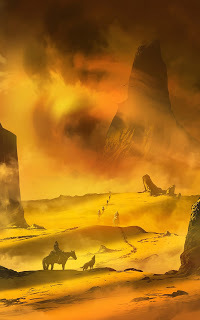 Beneath a Brass Sky (BaBS), my new fantasy novel, is now on Amazon for 99 cents! Link: https://www.amazon.com/dp/B08LZQJNCC/
Beneath a Brass Sky (BaBS), my new fantasy novel, is now on Amazon for 99 cents! Link: https://www.amazon.com/dp/B08LZQJNCC/
First, the Blurb:
Ulfric Halehorn is a sellsword that believes in the sanctity of the contract. He’s also rekindled an old grudge, incited a riot, and landed himself in jail on enough counts to see himself hung twice. In the midst of this, he somehow managed to win a lucrative contract to transport a mysterious crate across the Brasslands to Kush.
He’d be better off if he hadn’t.
Days into the journey, Ulfric learns that the job is more than it seems, and that he carries with him the spark that may touch off a revolution that could burn across a city, and perhaps an entire region. Knowing this, Ulfric sees a chance to atone for breaking another contract nearly a decade ago — one that cost another city its freedom and its people their lives; an act that still haunts him to this day.
But the Brasslands is a vast land, filled with fugitives, and wild beasts, and nameless things that lurk in the low dark. In those wastes also rides another — one charged with snuffing out the same revolution that Ulfric aims to set afire. And as these rivals drive towards their opposing goals, a storm of steel and blood is building on a bleak horizon.
BENEATH A BRASS SKY is a fantasy novel that fans of Abercrombie’s Red Country, King’s The Gunslinger, and Sanderson’s Alloy of Law will enjoy.
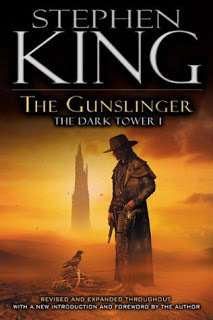 Stephen King, The Gunslinger
Stephen King, The GunslingerRed Country. The Gunslinger. Alloy of Law. Fantasy doesn't have enough novels with western genre influences, if you ask me. FJ Blair has the excellent Bulletproof Witch Series, too.
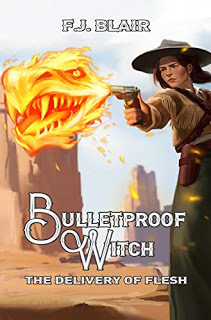 FJ Blair, Bulletproof Witch
FJ Blair, Bulletproof WitchBut BaBS is not your typical western-influenced fantasy novel. It's not weird west - not really.
If I had to compare it to a time in our world, I'd say it's in our 9th Century. No firearms; we're still firmly rooted in a sword and shield era. And there's a red-haired norse type (a Prydian, to be precise, in-world. Also known as a Valyncian by some. Name's Ulfric). And sellswords.
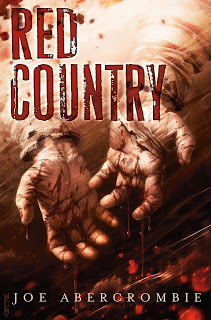 Joe Abercrombie, Red Country
Joe Abercrombie, Red CountrySo, where's the western influence without six-shooters and with not-vikings mercenaries?
In Ulfric Halehorn, the sellsword Valyncian for one. The lone "cowboy" (the knight errant). His values put him at odds with a world that's changed. Left him behind. And not for the better. At the fore of a good western is a man, a hard man (or woman), that refuses to bend to a changing world. Because their ways, the old ways, are better. At least as far as they're concerned.
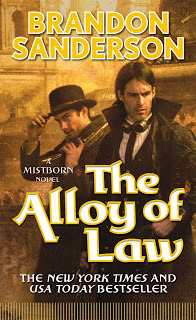 Brandon Sanderson, Alloy of Law
Brandon Sanderson, Alloy of LawThe environment, secondly. A good western has sweeping vistas, endless frontiers, unforgiving landscapes - hollow country that swallows men up. Oftentimes, the environment is as harsh a foe as the black hat in the story. Welcome to the Brasslands - a parched desolace as old as man's oldest flintknappings. A place of ruins, and wild beasts, and things that lurk in the low dark. Forgotten things. It's a place for fugitives to hide, or perhaps a place for them to hunt.
But what's a story without a black hat? I won't say much on this one, except: enter the Huntsman, who has to be my favorite antagonist I've written thus far.
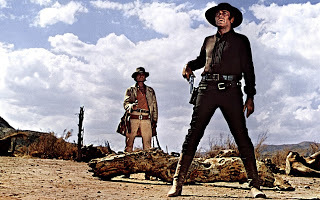
So is BaBS a western? In many ways, yes; but it's also still very much a fantasy novel with swords, and sorcerers, and alchemists, and maybe even a monster or two. But more than that, it's a story of redemption, and a story of finding yourself, and a story of revenge.
Beneath a Brass Sky, Available on Amazon: https://www.amazon.com/dp/B08LZQJNCC/
October 26, 2020
Beneath a Brass Sky, Cover Evolution - 1
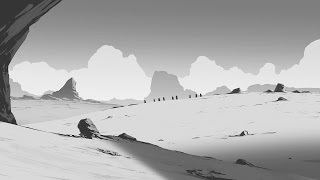
I'm a big fan of KVACM's art (https://www.deviantart.com/kvacm), so I'm delighted to have worked with him for the cover of Beneath a Brass Sky. Cost was $120 - $60 upon agreement of sketch (B&W images) and $60 upon completion.
The above illustration was his first-draft concept of the Wayfarers crossing the Brasslands. Conceptually, I though he did a great job capturing the desolace of the environment. From here, webegan to narrow in on the ratio (1.6:1 for an ebook cover).
In Part 2, I'll share the next roudn of revisions.

